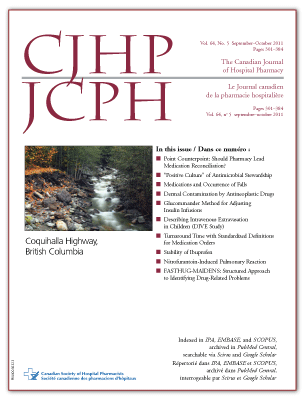Pilot Evaluation of Dermal Contamination by Antineoplastic Drugs among Hospital Pharmacy Personnel
DOI:
https://doi.org/10.4212/cjhp.v64i5.1067Keywords:
antineoplastic drugs, occupational exposure, dermal contamination, risk assessment, pilot study, agents anticancéreux, contamination professionnelle, contamination par voie cutanée, évaluation du risque, étude piloteAbstract
ABSTRACT
Background: It is believed that health care workers are exposed to antineoplastic drugs primarily via dermal contact. However, levels of occupational dermal contamination in Canada have not been formally investigated.
Objective: To determine the potential dermal exposure to antineoplastic drugs among hospital pharmacy personnel in a metropolitan area in British Columbia.
Methods: Six hospital pharmacies in the Vancouver area participated in this pilot study. Three pharmacy workers (a technician responsible for preparing drugs, a pharmacist responsible for checking drugs before administration, and a technician not responsible for preparing drugs but working in the pharmacy department) were selected from each site, for a total of 18 participants. Each worker’s hands were wiped with a premoistened tissue (one wipe per person), and the wipes were subsequently analyzed by high-performance liquid chromatography tandem mass spectrometry to determine levels of both cyclophosphamide and methotrexate (total of 36 analyses).
Results: At 3 of the 6 sites, at least one hand-wipe sample was above the analytical detection limit. Of the 18 analyses from the 3 “positive” sites, 5 (28%) had measurable levels of cyclophosphamide and methotrexate. Cyclophosphamide was detected in 3 samples (geometric mean 0.98 ng, geometric standard deviation 2.72 ng, range from below limit of detection to 3.96 ng) and methotrexate in 2 samples (geometric mean 0.27 ng, geometric standard deviation 2.57 ng, range from below limit of detection to 0.27 ng).
Conclusions: The results of this pilot study suggest that hospital pharmacy workers in Metro Vancouver are probably exposed to antineoplastic drugs, given that detectable levels of drug were found on the hands of some personnel. Further studies are recommended to confirm these findings.
RÉSUMÉ
Contexte : D’aucuns croient que les travailleurs de la santé sont exposés aux agents anticancéreux principalement par voie cutanée. Cependant, les taux de contamination professionnelle par voie cutanée au Canada n’ont pas fait l’objet d’études officielles.
Objectif : Déterminer l’exposition cutanée potentielle aux agents anticancéreux du personnel des pharmacies d’hôpitaux dans une région métropolitaine de Colombie-Britannique.
Méthodes : Six pharmacies d’hôpitaux de la région de Vancouver ont participé à cette étude pilote. Trois membres du personnel de la pharmacie (un technicien responsable de la préparation des médicaments; un pharmacien responsable de la vérification des médicaments avant leur administration; et un technicien non responsable de la préparation des médicaments, mais travaillant dans le service de pharmacie) ont été choisis dans chaque centre, pour un total de 18 sujets. Les mains de chaque sujet ont été essuyées au moyen d’une lingette (une par sujet), puis les lingettes ont été analysées par chromatographie liquide haute performance couplée à la spectrométrie de masse en tandem afin de déterminer les concentrations de cyclophosphamide et de méthotrexate, pour un total de 36 analyses.
Résultats : Dans trois centres, au moins un échantillon de lingette présentait une concentration supérieure à la limite de détection analytique. Des 18 analyses provenant de ces trois centres, cinq (28 %) ont révélé des concentrations mesurables de cyclophosphamide ou de méthotrexate. On a détecté de la cyclophosphamide dans trois échantillons (moyenne géométrique de 0,98 ng, écart-type géométrique de 2,72, plage allant d’une valeur sous la limite de détection à 3,96 ng) et du méthotrexate dans deux échantillons (moyenne géométrique de 0,27 ng, écart-type géométrique de 2,57, plage allant d’une valeur sous la limite de détection à 0,27 ng).
Conclusions : Les résultats de cette étude pilote suggèrent que les membres du personnel des pharmacies d’hôpitaux de Metro Vancouver sont probablement exposés à des agents anticancéreux, étant donné les concentrations détectables de médicaments trouvées sur les mains de certains employés. D’autres études sont recommandées afin de confirmer ces résultats.
Downloads
Published
Issue
Section
License
Copyright © Canadian Society of Healthcare-Systems Pharmacy.
After publication of a manuscript in the CJHP, the authors of the manuscript must obtain written permission from the CSHP (publications@cshp.ca) before reproducing any text, figures, tables, or illustrations from the work in future works of their own. If a submitted manuscript is declined for publication in the CJHP, all said rights shall revert to the authors. Please note that any forms (e.g., preprinted orders and patient intake forms) used by a specific hospital or other health care facility and included as illustrative material with a manuscript are exempt from this copyright transfer. The CJHP will require a letter from the hospital or health care facility granting permission to publish the document(s).










